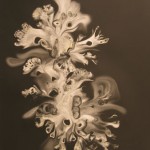After spending multiple hours at both Hawk Mountain and Cabela’s this past Saturday, and after much time thinking about the relationships they have to each other, to people, and to the environment, I was able to compartmentalize each place’s role in society. Hawk Mountain Sanctuary didn’t seem like an unusual site to visit for our class (which might generalize that everyone in our class is interested in nature and its conservation) but Cabela’s was equally as important for our class to see –how the “other half lives”. My initial feeling of both places, Hawk Mountain fitting our stereotype while Cabela’s did not, was slowly broken down after the time spent at each location.
Hawk Mountain is considered a “traffic bottleneck” for birds migrating south for winter, according to Rachel Carson. At first, back in the day when conservation was a rare word to come by, hunters abused this vantage point until the 1930’s when it was converted into a sanctuary to stop the killing of raptors. This spot is very popular amongst bird watchers, students, boy scout troops, environmentalists etc. because the scene is awe-inspiring. At first I wasn’t too enthused by the bitter cold and the craggy rocks, but I was soon convinced of the beauty of the spot. This spot proves that those birds’ migration have been unaffected by humans over thousands of years, and the Sanctuary’s existence allows for them to continue on. Those of us perched on the mountainside were learning, teaching, and observing with each other, which is reminiscent of other experience’s I’ve had in nature but never in a department store. The people on the mountain were young and old, from near and far, and most had the same goal of being there- to watch the raptors drift with the exceptional winds provided by the landscape. Maybe some were forced to be there or just wanted views of the autumn landscape, but everyone was seeing and hearing the same things. No one is intentionally excluded from experiencing Hawk Mountain Sanctuary while that didn’t seem the case in Cabela’s.
The health and abundance of birds of prey in the US is a reflection of the country’s regard and regulations for human and environmental health. Herbicides and pesticides were not regulated, which means that they weren’t tested before widely implemented across massive regions. It was apparent at this time that the United States’ love for industry prevailed and the environment lost. Cabela’s reminds me of that time, it seems caught in the past while the rest of the nation is moving forward. Cabela’s average consumer would be on Hawk Mountain pre-1930’s conservation movement. Today’s Hawk Mountain sanctuary hiker would rarely be seen in a Cabela’s store. Although the stores are filled with merchandise from hunting to camping to home décor, the taxidermy and store environment cater to an audience that views nature through different lenses. The audience might not always be there for nature, which was the issue my group encountered while roaming the store. So many guns, so many people buying guns, and so little regard for who and what they’re buying. This statement is bold, but we were shocked at the quantity of handguns Cabela’s sold because they are a recreation store that promotes hunting, not defending oneself.
Both locations are considered great establishments, using nature to further their establishments. Both locations are also very dependent on the animals. If Hawk Mountain didn’t serve the birds during migration, no one would fund the organization. If hunted animals went extinct, much of Cabela’s business would flounder. I believe that Cabela’s relationship with Hawk Mountain isn’t direct, but Cabela’s supports hunters who shoot animals, which may include birds of prey. Hunting is a past time and it built this country’s industry in the 16th and 17th centuries, yet in today’s situation I believe that sport hunting of animals with low populations falls below the importance of animal and nature conservation.

